The mid-back (and lats) make up a considerable amount of muscle mass in the body and training those muscles groups effectively should be a key part of any good training program. In terms of maintaining good shoulder health and posture, along with developing musculature that contributes significantly to overall mass; training the back properly is key. Unfortunately, many trainees either pay little attention to the back or train it so ineffectively as to make that training, well…ineffective.
Today I want to look at some common cable row variants noting that most of the comments I’m going to make can be equally applied to barbell or dumbbell rowing or even various rowing machines. So don’t get hung up on the fact that I took pictures of a cable using specific attachments, it’s the mechanics of the different movements that is the key.
Table of Contents
Muscles Trained in the Cable Row
Cable rows can hit a variety of different muscles depending on the specific variant performed. Lats, mid-back (teres/rhomboids), traps, biceps, rear delts, and spinal erectors can all be hit in one fashion or another depending on the type of row done.
Even the triceps long-head (which is involved in shoulder extension) gets some work from certain types of rows. Basically, as one of the ‘big’ compound movements, rows can work a lot of stuff in a very small amount of time.
Basic Cable Row Technique
First I want to show the basic starting and ending position for a parallel grip row. In the start picture (left) note that the torso is leaned only slightly forwards with the knees bent and the back held straight. I want to comment that some rowing variants include flexion (bending at either the upper or lower spine) so that, with extension, there is more dynamic work thrown onto the spinal erectors.
I didn’t take photos of that since I’m focusing here on the midback and lat muscles specifically. In the end position, note that the elbows are slightly behind the body, the shoulders are pulled back and the chest is lifted (with a slight arch in the upper back).
This is key to getting a good contraction in the back. You’ll also note that, because of the elbow position, the handle hits the body in approximately the middle of the torso with the forearms perpendicular to the line of pull.


Note the finishing position of the handle which is at the stomach. The key here is that the forearms are basically parallel to the floow.
Common Cable Row Errors
In the next series of photos, I want to contrast a proper end position (above right) to what is typically seen in the gym. In the leftmost photo, I’ve reproduced a proper ending position. In the middle picture, I’ve shown what typically happens when either too much weight is being used and/or the trainees pecs and shoulders are too tight to allow for proper mechanics to be used.
Note that the chest is dropped, the shoulders don’t get pulled back and, frankly, the back isn’t being utilized very effectively. Individuals who use this type of form are usually the ones who complain that all they get out of back work is fatigue in their arms. That’s because they aren’t using their back muscles to any great degree. Folks who insist on putting way too much weight on the machine are the ones who report this.

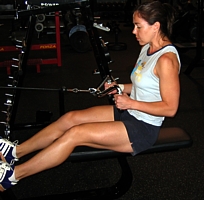
Another common flaw, again seen in folks using too much weight is to turn the movement into a back extension and lean too far back. Again, I’ve shown a proper finishing position (left) with an extreme improper position on the right.

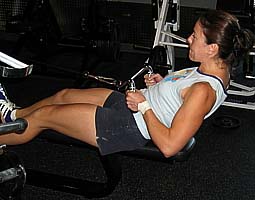
I’d note again that the cable row is sometimes used to do back extensions (and to train the hamstrings), typically by keeping the arms straight and doing almost an RDL type of movement (an exercise I’ll detail in an upcoming article). For the purposes of training the back, the above right picture is an incorrect finishing position.
Cable Row Technique: Back View
Moving around to behind the trainee, I want to show what it looks like from the back for the proper finish versus rounded shoulders position (shown two sets of pictures above). On the left, you can clearly see how the trainees shoulders are back and their shoulder blades are pulled together.
On the right, the shoulders don’t get pulled all the way back and the mid-back muscles aren’t getting trained effectively. The trainee on the right needs to drop the weight and make sure that they get their shoulders blades pulled together at the end of every rep.
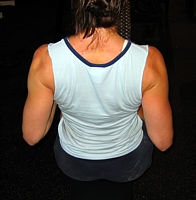
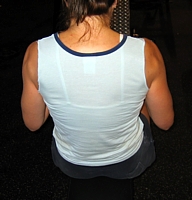
The next common error I want to show is a subtlety involving shoulder position. In the left picture below, the trainee (in addition to everything above) has scooped their shoulders down and back with the shoulders kept down at the end of the movement.
In the right picture (and this is a little tough to see; it’s usually more exaggerated than this) the shoulders are hiking up towards the ears. You can see the tension in the upper traps in the right picture compared to the left if you look closely.

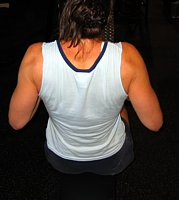
This tends to happen when the muscles which raise the shoulders (upper trapezius/levator scapulae/scalenes) are tight and the muscle which keep them down (lower traps primarily) are weak. Stretching the traps/levator between sets and actively trying to scoop the shoulders down and back not only helps correct this flaw but also helps to re-balance the muscles that keep the scapulae in place.
Cable Row Variations
Having examined the basics of cable row form (which applies to all variants), I want to talk a little bit about how different grips/handles/pulling positions affect the musculature of the back.
The main muscles I’m going to focus on are the midback (teres and rhomboids) along with the lats and biceps since those tend to be the muscles most drastically affected by changes in grip position and width.
I’d note that the traps (which is a complex muscle with 4 different segments pulling in different directions) can also be targeted differently depending on which variant is done. I’ll save trap training for another article so I can get into proper detail with it.
Done properly, all cable row work should hit the mid-back, assuming that the shoulder blades are pulled together properly at the end of the movement. The big differences tend to be how much the lats and biceps contribute.
I’d note that, in some people (with strong lats and a weak mid-back), lat dominant rowing can overpower the mid-back with the lats handling nearly all the work. In that case, picking a variant that takes the lats out of the movement may be a better option.
Parallel Grip Cable Row
With the parallel grip handle (which was used in the basic technique demonstration), the biceps themselves don’t have a great line of pull although the brachialis muscle will be used heavily (like a hammer curl). Because the elbows are down by the side of the body, the lats (which contribute to shoulder extension) will contribute significantly to the movement along with the midback.
Undergrip Cable Row
A similar pulling position is the narrow under-grip shown below from both the front and back You’ll note that the hands are about shoulder width and the forearms end up perpendicular to the bar (avoiding wrist stress). The bar also hits the body lower compared to the parallel grip handle, about belly button level.
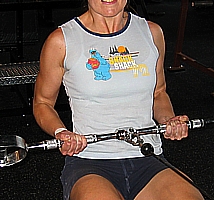
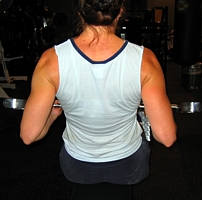
With the under-grip, the biceps can provide the most contribution compared to either parallel or overhand variants. As well, the mid-back and lats are also involved heavily. Frankly, if I wanted to or had to pick a single pulling movement to hit the most muscles at once, this would probably be it. You can hammer biceps, lats and mid-back in one movement.
This variant of the row also tends to be the safest movement for the shoulders since it tends to be the easiest to keep the shoulders down and requires the least amount of scapular/rotator cuff control to avoid problems. The key is to focus on scooping the shoulders down and back as you row.
Overhand Grip Cable Row
At the other extreme is an overhand fairly wide grip pulled basically in line with the pecs. The gym we were at when we shot these pictures didn’t have a bar as long as I’d like and this grip is actually a bit narrower than I’d normally recommend; I like to see the forearms parallel to the handle (you can see how the wrists and forearms are angled in in the picture below).
This is shown from the front and back below, note that the bar also hits the body higher up (around sternum level). You can also use this pulling position with many parallel grip handles (not shown) instead of the overgrip but everything else is identical.
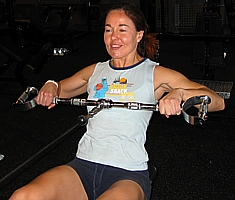
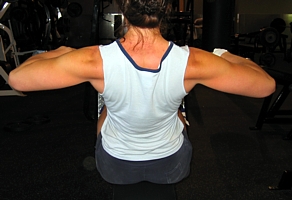
With this grip and pull position, the lats have a poor line of pull and don’t contribute nearly as much compared to parallel or underhand rowing; the majority of the stress is thrown onto the mid-back muscles (the rear delts are also worked very heavily).
This is a good movement when really want to hammer the mid-back without hitting much lat, but tends to require the most shoulder/rotator cuff control to keep the movement safe. It’s crucial to actively keep the shoulders down to avoid any problems with shoulder impingement. If your shoulders hike up as shown in the basic technique section, you can expect shoulder problems to follow.
Medium Grip Cable Row
Somewhere between those two extremes is a medium grip cable row. This can be done overhand or with a neutral grip (shown), pulled to slightly below the pec line. In this one the bar is a bit longer than I’d like and the forearms are pointed out instead of being parallel. Normally I’d use a standard lat pulldown bar and have the hands in a position such that the forearms were perpendicular to the bar at the end of the movement.
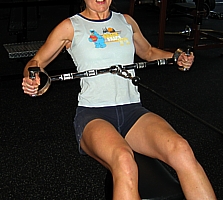
Other Cable Row Variants
Of course, there are still other variants that can be done. Using a single cable crossover handle, any of the movements shown can be done one arm at a time; keep the elbow down and pull low to focus on lats or keep the elbow high and pull high to focus on mid-back.
As well, all of the above concepts apply equally to other forms of rowing such as barbell rows (which can be done undergrip pulling low to the belly or overgrip pulling to either the top of the stomach or the chest) as well as dumbbell rowing.
A 1-arm DB row can be done with the elbow tight to the body (as in the undergrip or narrow grip row) for more lat emphasis or with the elbow flared out (as in the wide grip row) for more mid-back.
The same can even be done with body weight inverted rows (done hanging from a bar). A narrow undergrip pulling to the belly is the same as the narrow undergrip described above and hits more lats; wider grip with elbows flared is the same as the wide grip row and hits more mid-back. I think you get the idea.
Various machine rows also exist and usually offer at least two different pulling options. Generally, a handle pointing down (which keeps the elbow down, for lat emphasis) and a handle that is horizontal (keeping the elbow high for more midback) are offered, some machines have even more options than that.
As a final comment, one way I have long preferred to do rows is with a 1-2″ (or longer in some cases) isometric hold in back. Not only does this tend to force good form, it can also go a long way towards retraining the crucial postural muscles in the mid-back since more and more people are tending to adopt a rounded upper back hunched posture from sitting in front of the computer.
The key to making this effective is that the movement should end with the chest high, upper back slightly arched and shoulders pulled all the way back and held there through the length of the pause. This will generally necessitate a fairly large reduction in weight at least initially.
Similar Posts:
- Lat Pulldown Technique
- A Guide to Bench Press Technique
- Are Upright Rows Unsafe?
- Benching with the Pecs
- Back Extension Technique
Thanks for this …
I’m going to try the isometric hold you mentioned …
cheers
In the 1st cable row finish position picture it appears that she is hyperextending the humerus to compensate for not achieving full scapular retraction. It looks relatively subtle there, but over time it can give some people issues with the anterior capsule of the GH joint.
I consider full range of motion to have the humerus breaking the plane of the torso. How far back that will be will depend on factors such as arm length, etc.
I also have no idea how you can tell if she’s retracting her scapula or not from that view.
Lyle
Lyle,
Thank you for putting out articles at such a high rate.
About the undergrip row you note, “if I wanted to or had to pick a single pulling movement to hit the most muscles at once, this would probably be it. ”
I was thinking an underhanded pendlay row would be the best single movement to hit the “Lats, mid-back (teres/rhomboids), traps, biceps, rear delts, and spinal erectors.”
Which of the targeted muscle groups above would you say the underhand pendlay row can hit that the narrow underhand chin won’t hit? Spinal erectors and mid-back? Do you think a program doing underhand pendlay rows is made that much more complete by adding chins or some form of vertical row?
Matt
Ive always been against large torso movement in this exercise as it gives the weights speed upwards and eases the work done by the back.
However i see you have some torso movement in the first pictures, is there a reason for this, and is this superior to having a static torso 90 degrees to the floor or static slightly leaned back (like img 2).
Exog: assuming the lifter isn’t throwing the weight or swinging excessively, allowing a touch of torso movement will let more weight be used. Trying to keep this one too strict tends to really limit the weight that can be used so I allow a little bit more slop. Again, that’s assuming the lifter isn’t making it into a whole body throw and heave. I’d also note that rows are one of those movements where form can go from great to crap with the smallest weight increments.
Matt: I don’t know that an undergrip pendlay row will majorly hit anything that much differently than what you’d get with an underhand cable row. Spinal erectors are still stabilizing in the cable row against the pull of the stack and assuming upper back says slightly arched, it will be too. The mechanics of the two lifts are basically identical so I’m not sure there will be meaningful differences in muscular involvement.
Whether I’d add more lat or midback work to that movement would depend on the individual and their goals and needs. As noted in the article, some folks get so strong/lat dominant in undergrip rows that midback actually doens’t get much of a training stimulus. In that situation, I’d add a very specific midback exercise (like a high elbow row of some sort).
Whether extra lat work would be indicated would simply depend. Undergrip row only works the shoulder extension aspect of the lats, if someone had a need to work the lats as humeral adductors (what happens with a medium grip overhand chin), I might add that to the program in the form of a medium grip overhand chin or pulldown where the elbows are flared out and come down in line with the body (I hope that description makes sense).
Lyle
Great article, thanks! I really appreciate the level of detail you go into. Just wondering if you coach the Hammer High Row the same way, in terms of:
a) how far back to bring the arms at the end of the movement, and
b) rounding of the back
I’ve always set the seat quite low in order to start the movement from a loaded stretch, but that tends to mean starting in a somewhat rounded back position. And I’ve always aimed to have the upper arm parallel to the torso at the bottom of the movement, but I could lower the weight in order to bring the elbow past the torso if that is more effective, it would probably add another 4-6 or so inches to the ROM.
My gut says that if you’re having to round your back at the start position you may be too low. I’m actually having trouble visualizing how this would happen.
Beyond that, everything is the same (Hammer Hi-row is one of my favorite machines). The shoulders must scoop down and back (this is especially critical to get sufficient Traps III/IV activation), the chest should finish high with a slight arch in the upper back.
The issue of elbow position is sort of weird: up to a point, you must get the arm back and scapula retracted to get full back activation. However, beyond a certain point most of the arm movement is related to rear delt strength as you’re not getting any further retraction of the scapula.
So you end up really limiting poundages trying to get a full full full ROM. If that makes sense. As noted above, I like to see the elbow break the plane of the torso, and be at least slightly behind it. While it is possible to do that without getting full scapular retraction, someone who has been properly coached won’t be doing that. Beyond that point of full scapular retraction, trying to get the elbows further back tends to be limiting, rear delts will limit the poundages and there is little to be gained.
I hope that makes sense, tough to describe without pictures.
Perhaps this is somewhat outside of the specific topic of rows, but while we’re discussing lats …. When doing lat pulldown, pull-ups/chins, is the old “wide grip for wide lats” thing accurate, at all? I used to do more underhand/closer grip chins, due to the increased stretch on the lats, but it would seem that the overhand/wider grip may indeed target the outside/width part of the lats. True?
For the most part, bigger lats = wider lats and picking the variant that lets you hit the lats the best is going to be superior. I would suspect that, if anything contributed to the old belief of ‘wide grip = wide lats’, it’s that a wide grip tends to take a lot of the biceps out of the movement, they have a poor line of pull. That forces the lats to do the work. So for guys who were probably using too much biceps in their narrower grip work, using a wider grip forced them to actually use the lats. Hence they grew. Hence they got ‘wider’.
I’ll be addressing pulldowns in some detail in a later article.
thanks Lyle, that makes sense. I’ll try to get make a video of myself, not super worried as I do direct rear delt work besides, but maybe for my next training cycle I’ll drop the weight, focus on form, and ramp up again.
Question: My training routine rarely includes rows; I primarily deadlift and do chins/pull-ups to work the back. What are your thoughts on using the deadlift and chins/pull-ups as a sort of catch-all for the back muscles?
The question will ultimately come down to whether or not DL’s are adequate hitting the midback or not. For some they may be sufficient, for others an active row (focusing on dynamic scapular movement) will probably be necessary. A couple of sets of rows following deads would be a likely useful addition even to the dl/chin combination IMO.
Lyle
Lyle,
Do you feel that improvements in the deadlift and machine pullover (if available) will carry over as an increased ability to recruit/activate the musculature of the upper back during rowing variants?
With regards to a wide grip = wide lats, it would seem like there is a potential for a bit of extra stress on the very outer fibers of the lats due to fiber segmentation, but that seems to be counteracted by the reduced ROM so who knows if there is any net effect on lat growth. I definitely agree with your saying that the best exercises for lat width will be whichever ones elicit the most growth for a particular trainee.
As far as elbow position relative to the torso at the end of the concentric ROM, I always used the rule of thumb that when the scapulae stopped moving, so too should the humerii.
I realize that this article pertains to the cable row, but since I briefly mentioned pullovers at the beginning, do you have any opinion on the value of machine pullovers and whether some of the current options available (Nautilus Nitro Plus Pullover, Hammer Strength, Cybex, etc.) are as effective as the old Nautilus 1st generation or if they are inferior as some would lead you to believe.
Thanks for the knowledge!
Pullover…I doubt there will be much help to mid-back activation since there’s little to no active scapular retraction.
Deadlifts, might be some carry over. A lot will probably depend on how good they are at activating the midback during the deadlift in the first place.
Tangentially, IME, most people have a lot of trouble activating their midback when they begin training. Some of it is due to posture being poor, some of it is not being able to see what’s being done.
When I have taught cable rows hands on, I find that manually cuing the retraction of the scapula does wonders. I’ll put the fingers of one hand on the scapula and actively cue bringing them together during the movement. This not only helps folks understand what they are trying to accomplish but also gives them something to focus on muscularly.
I’ve also taught shrugbacks (pure scapular retraction without the arm bend) prior to full cable rows for the same reason. Sometimes a rep or two of shrugbacks prior to cable rows helps to ingrain this as well.
As to the machine pullover, I think it’s one of the places where machines are demonstrably superior to any free weight or even cable equivalent.
DB pullovers are, IME, a waste of time, the line of pull is all wrong and there is zero resistance at the top which is why so many people can move such absurd weights over tiny ROM’s. As long as they avoid the point where the arms are straight overhead, the lever arm becomes insanely smaller.
The cable pullover (standing facing a stack)is an improvement but usually limits range of motion because the plates hit either the top or bottom before full ROM is reached at the top or the bottom.
The machine pullover eliminates all of those problems and is an amazing way to hit the lats, assuming it’s done correctly, without use of the biceps. It’s a great finisher at the end of a back workout when the biceps are fried but you need or want more lat work.
I’ll be honest that I’m no sure I’ve ever actually used an old style Nautilus pullover. I’ve used Cybex (at a gym back in Austin) and the gym we’re at now has a Hammer machine (which primarily lacks for a foot plate to help start the movement to avoid shoulder problems). All of the machine I’ve ever seen, used or trained people on seem to work as well as any other.
And I think we’re all in agreement about the humeral/scap thing. I just wasn’t sure how Mats could see what was going on from the side, I agree that once full scap retraction has bene reached, there’s little additional advantage to more ROM (esp. since it’s limited by rear delt strength more than anything to do with the back). It’s just where that point will be is going to depend on individual mechanics.
My question is about the beginning position of a row. Should I maintain at least a slight scapular retraction at the beginning or should I put the scapulae in a protracted position at the start?
Thanks,
Marc
Marcc,
The latter. The scapula need to protract at the ‘front’ of the movement, if you’re keeping it retracted, you won’t be getting optimal dynamic training for the scapular retractors.
However, don’t let the shoulder overstretch or relax completely as that can stress the rotator cuff. It can be a fine line sometimes. I hope that makes sense.
Lyle
Thanks,
Yes, this does make sense.